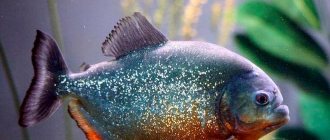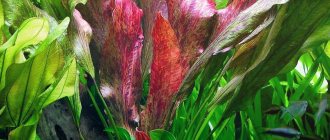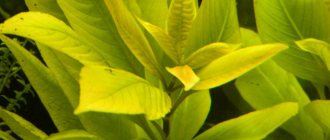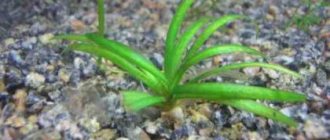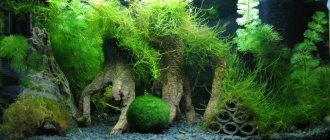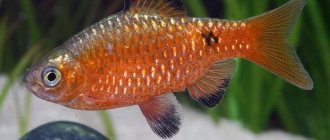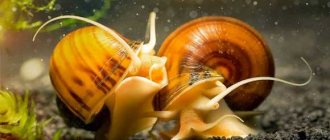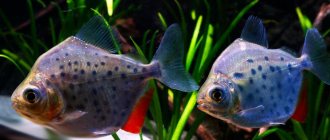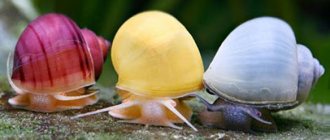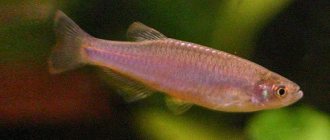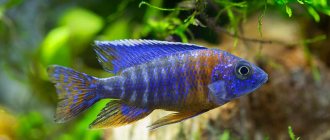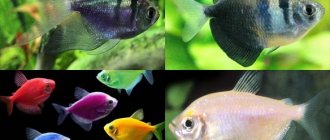Avid aquarists love not only fish: they create a real oasis for their pets, which is a comfortable home for them, pleases the eye and improves their mood. Such aquariums become a real source of pride for their owner, as they ideally combine conditions for the comfort of the inhabitants and an impressive appearance. When creating green spaces in your aquarium, use nymphs, especially for decorating large containers.
What you need to know about the nymph
This plant is a real decoration for any aquarium. If desired and properly cared for, the nymph not only unfurls bright above-water leaves, turning the aquarium into real thickets of an oasis, but also blooms with delicate above-water flowers.
One of the important features of care is the plant’s love for settled water. This should be done to saturate the water with humic acids.
The birthplace of nymphs is freshwater bodies of West Africa.
This plant thrives in warm aquariums with a temperature of 26-28°C and a depth of at least 45 cm. It prefers bright lighting, direct sunlight and long daylight hours (12-14 hours). With a shortened bottom, the leaves become smaller, more of them develop under water without coming to the surface, and the color becomes faded.
Distribution area
Under natural conditions, nymphs are found everywhere in the equatorial, temperate, tropical and subtropical climate zones. Plants grow in river backwaters and swamps.
Some breeders believe that the homeland of Nymphea Tiger is the marshy areas of West Africa. But most agree that this is an artificially created hybrid.
Species diversity
Despite the fact that this plant has a fairly long list of varieties, there are several varieties that are most popular among aquarium and pond lovers:
| One of the most attractive varieties. It is valued by its owners not only for its interesting floating flowers, but also for its large, brightly colored leaves. Divided into 2 types: red and green. The first has underwater leaves that are all shades of red. Planted in a container at least 45 cm deep with a large area of water, temperature 28°C. At temperatures below 22°C, growth stops and does not bloom. |
| The interesting shape of the rounded leaves is loved by many: it grows and develops best in the summer; in winter, with short daylight hours and low temperatures, growth significantly slows down. The volume of the bush and the number of leaves depend on the area of the aquarium. |
| This rather voluminous bush is distinguished by its bicolor: the underwater leaves are a very contrasting red-green color, while the above-water leaves are solid green. After the formation of floating leaves up to 30 cm in diameter, the water lily blooms, which will become a decoration for the aquarium. |
| This type of nymph is unpretentious to the hardness and acidity of water, and at the same time has an attractive appearance: the upper part of the leaves is bright green, while the lower part is decorated with lilac and purple spots. The more light the plant receives, the more contrasting the colors will be. |
| This rather capricious species is distinguished by the fact that the leaves are painted in all shades of red. It is demanding on the composition of the soil and attention to its flower. If you manage to achieve flowering, you can see that the color of the flowers is quite varied. The center has a more saturated color, and the edges are usually light. |
Description
Nymphea is a plant with long cuttings and wide leaves with a diameter of 15-30 centimeters. Shoots can grow up to 70 centimeters.
Nymphea feels better outdoors, but has also adapted to aquarium keeping.
Leaf blades are round or heart-shaped. They are painted green or burgundy. The lower part of the leaves is purple. When exposed to sunlight, it turns purple. The root system of the nymph is well developed.
In favorable conditions, flowering occurs in mid-summer. Lotus buds are colored white, blue, red, pink. Petals are oblong. The core of the flowers is yellow. When the lotus is blooming in the aquarium, it is necessary to maintain the water temperature at least 24°C.
Since the nymphea has an impressive size, a reservoir for it must be selected with a volume of at least 250 liters.
Recommendations for care and maintenance
The main criteria for the full growth of an aquarium nymph:
- lighting;
- temperature
- hardness of water;
- acidity indicators;
- regular care.
The condition for normal life activity, intensive growth and abundant flowering of nymphs is compliance with temperature and light conditions. These plants thrive in warm aquariums with a water temperature of 24-28°C; when it drops below 22 degrees, the water lily stops growing, does not unfold its surface leaves, and does not bloom.
In addition, the most rapid growth occurs in bright light. It is possible to use natural and artificial light: use fluorescent, special phytolamps to maintain the lighting of the aquarium.
The recommended length of daylight for this representative of the flora should be at least 12-14 hours.
If everything is done correctly, a beautiful bush with large floating leaves will appear, regularly pleasing the eye with flowering. With little light, the leaves become dull, the cuttings become elongated, and the plant loses its attractive appearance.
For the full functioning of the bush, soft water is recommended, 4-6 dGH. Too hard water causes the plant to become too bushy, have small, hard leaves, and stop flowering.
Useful lifehacks
For successful cultivation, we offer several “working” tips and notes:
- If the water hardness is more than 6°, the nymphea forms a large number of root layers. This contributes to the formation of dense thickets that should be thinned out. Otherwise, the plants weaken and stretch upward.
- The purple tint of the leaf blades is neutralized under artificial lighting.
- In large tanks, it is preferable to plant nymphs in pots and change the soil annually.
- Iron should be added separately from other microelements. Otherwise, it will turn into a trivalent form, which is not suitable for plants.
- During transportation, the bush should not be squeezed, as the delicate leaves of the nymph may be damaged.
- To ensure that the adaptation period does not last 2 weeks, but is reduced to 3 days, you do not need to bury the plants in the aquarium soil, but lightly press them down with small stones.
- Heavy pruning is fraught with rotting of the roots, which occurs due to a violation of the stem-root balance.
- To prevent thickets of young plants from oppressing the mother bush, the nymph should be replanted regularly. The optimal time for transplantation is March.
- If after transportation the leaf blades dissolve in the aquarium water, do not throw away the bush. Thanks to the developed root system, the plant will recover in 1 month.
- If it is necessary to stop active development, less bright lighting and cold light should be used.
How to plant a nymph correctly
The root system of the water lily is quite powerful, yet delicate. Planting requires soil with a high content of organic matter.
Garden soil is not suitable: it can change the chemical composition of the water, and this will harm the health of the fish. It is recommended to use small pebbles as a base, to which add clay, peat, sand and charcoal.
Name variations
Nymphea Tiger has several name options:
- Tiger water lily;
- Nymphea tiger red;
- Nymphea Lotus;
- Tiger Lotus;
At the same time, do not forget about the names of varietal varieties.
Reproduction
The reproduction cycle of nymphs is simple: the plant is well-produced by cuttings. After the water lilies fade, young shoots begin to grow from the mother root. They need to be carefully cut off from the main plant and planted in a separate container. After adaptation, the young plant is ready to be planted in the aquarium. To quickly root a young plant, you can use Tetra PlantaStart fertilizer.
It is recommended to thin out the nymphea regularly so that the bush has a neat appearance. This stimulates the growth of new young shoots, the plant looks lush and dense.
During the period of transplantation and adaptation, strict control of water parameters is required. The acid-base balance of the container with young plants should be within acceptable limits, and the temperature should not be lower than 26°C.
An alternative method of propagating water lilies is growing from seeds. This is a more labor-intensive method: to obtain seeds suitable for planting at the end of summer, you need to artificially pollinate the flowers using a soft brush. Ripe seeds are planted in sandy bowls covered with water.
Secrets of cultivation
“Nymphs are fans of proper nutrition, so they need to be fed more often and using complex, balanced formulations”
The main questions that arise for those who want to have a red nymph or another subspecies of water lilies in a pond are related to the procedure for planting, care and wintering.
Planting a nymph
Proper planting of water lilies in a pond will help you avoid disappointment in breeding water lilies. The ideal option would be to fill the basket with a mixture of sand, peat, black soil and clay.
All these components are very important for the formation and life of the nymph. But what about the pebbles recommended for use by experts? It is certainly needed, but only on the condition that the flower will live in a small tank. In a more or less spacious pond, the presence of pebbles is extremely undesirable, since the stone is capable of changing the composition of the water at the chemical level.
Planting a nymph in a pond
Top dressing
Nymphs are fans of proper nutrition, so they need to be fed more often and using complex, balanced formulations. The highest doses are given to water lilies during the growing season. Mineral fertilizing is applied weekly. The red nymph really likes meat and bone meal rolled into balls. It should be laid when planting the plant. The ball is placed between the roots.
Feeding the nymph
Basic care
When growing water beauties, it is important to monitor the purity of the water. Not only the aquarium nymphea plant needs fresh water, but also varieties growing in open improvised lakes. You should not be lazy, regularly clean reservoirs of dirt accumulations, and, if possible, also change the water in them.
Clean your pond regularly
Organization of wintering
The most frightening moment for beginning “water lily growers”. Nymphs in the aquarium are not threatened by sudden temperature changes and severe frosts. To keep the nymphs in the pond, you will have to try. If non-frost-resistant species are planted there, the plants will have to be removed from the pond and sent to the basement for the winter. The departure of a water lily for winter rest is not a reason to forget about caring for it. The flower will need water added to the container, as well as additional lighting.
Preparing nymphs for wintering
Frost-resistant individuals can remain for the winter in their familiar environment. If they are provided with high-quality insulation, then the plants will not have problems. You can insulate a pond... with snow. It sounds illogical, but the method is time-tested and really works. It doesn’t bother you in implementation either. All that is required is to simply shovel excess snow, which will always form when cleaning garden paths, onto the frozen surface of the water. The higher the snowdrift is above the pond, the more comfortable the water lilies will overwinter.
Why doesn't the nymph grow?
A tropical plant in its natural environment receives quite a lot of light and loves a warm, humid climate. Therefore, when breeding nymphs, you need to take into account that shortening the daylight hours will significantly affect the development of the water lily. The lack of light does not allow the plant to “drive out” the above-water leaves; their color becomes pale and dull. Due to this, the decorative value of the species is lost.
Low temperatures stop the movement of plant juices, because of this, growth slows down, the leaves become small and hard, and the plant may die.
In addition, nymphs are sensitive to the hardness and acidity of water. Maintaining these indicators at normal levels will enable the water lily to fully develop and delight with its beautiful shape and color.
Landing
For planting nymphs, a substrate consisting of small stones, peat, clay, and charcoal is used. The crop will develop better in fertilized soil. Therefore, bone meal can be added to the substrate. To prevent the fertilizer from crumbling, roll balls of clay and bone meal and place them under the rhizomes. If you place flour in the aquarium differently, the fertilizer will greatly spoil the water quality.
Sprinkle the substrate on top with a small layer of small pebbles. It will prevent soil erosion and the plant from floating up. It is necessary to ensure that the root collar is not buried.
The nymph can be planted not immediately in the aquarium, but first in a clay pot. Drainage made of pebbles is placed at the bottom of the container. Then lay out a substrate consisting of earth, humus, peat, sand, and charcoal. When planting a nymph, the top of the pot is filled with sand. The container with the plant is placed in the aquarium.
After transplantation, the development of the nymph slows down. But after 2 weeks adaptation occurs and active growth begins.
Fertilizer use
A powerful root system, strong cuttings and large leaves require additional feeding, especially during the period of reproduction, rapid growth and flowering. The use of special soil will eliminate the need to use humus, and the application of mineral fertilizers will give the plant the strength to develop stronger and more voluminous leaves, and will make the flowering period itself longer. The plant loves iron supplements, which prevent premature yellowing of the leaves.
Nymphea is a rather whimsical aquarium plant. However, if you comply with all the conditions for maintaining and caring for this plant, then it can make the aquarium original and very attractive.
Breeding
You can propagate nymphs yourself vegetatively and with seeds. The second method is painstaking and time-consuming. Aquarists rarely use it. You need to know that without artificial pollination, seeds are not formed . To do this, you need to run the brush along the stamens, then along the axils of the petals.
14:47
NYMPHAIA (WATER LILY) - planting, care, reproduction in natural and artificial reservoirs
06:58
How to grow an adult plant from a baby nymph?
08:49
NYMPHAIA FOR POND. CARE AND REPRODUCTION
Vegetatively
Young shoots grow from the root system. When the bushes grow to 15 centimeters, they are carefully isolated from the mother crop. The separated plants are planted in the substrate. They are grown at a temperature of 26°C.
Separating the shoots from the mother plant is not difficult.
Seeds
Reproduction is done as follows:
- peat is poured into a container with low sides;
- water abundantly;
- place the seeds and cover with wet peat;
- grown plants are planted separately;
- watered, fed.
When the bushes develop well, they are planted in a pond.
Sprouted nymphea seeds are the result of a lot of work!
